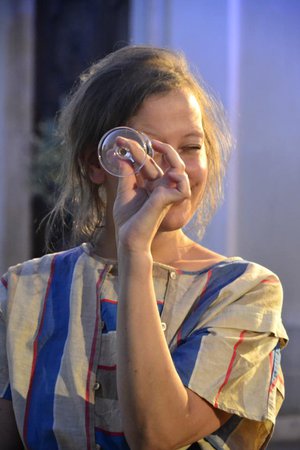Sound Artist in Residence, Signe Lidén
 Based in Bergen and Amsterdam, Signe is an artist of
international repute whose installations and performances examine how places and their histories resonate: in memory, through narratives and
various materials, as ideological manifestations and as political territories. Her
work spans from sound installations, sculpture, video and performance
to documentary forms such as sound essays and archives.
Based in Bergen and Amsterdam, Signe is an artist of
international repute whose installations and performances examine how places and their histories resonate: in memory, through narratives and
various materials, as ideological manifestations and as political territories. Her
work spans from sound installations, sculpture, video and performance
to documentary forms such as sound essays and archives.
Her marvellous new installation "Field Modulations" (created expressly for the St John's College Barn) will open for members of the public this week during the following times:
- Tuesday, 9 October: 12pm-2pm
- Wednesday, 10 October: 3pm-5pm
- Thursday, 11 October: 12pm-3pm
- Saturday, 13 October: 1pm-3pm
We have also invited Barbara London, formerly of MOMA in New York to give a lecture on Wednesday, 10 October in the College Barn at 5pm which is open to members of the College. Signe will also be giving a talk to College members about her artistic practice on Friday, 12 October in the College Barn at 5pm.
Signe
is particularly interested in collaborating with members of the St
John's community (from first-year undergrads to DPhil students, from
fellows to staff). Her work is highly interdisciplinary, and her goal this term is to work
with students, faculty and staff from across a range of disciplines.
Further info can be found at: http://signeliden.com
Field Modulations, Signe Lidén (2018)
An
acoustic canvas spans the gallery space. A piece of iron ore, turned
into a speaker coil, is sounding from beneath. Resonances from the stone
echo in the fabric, accompanied by the sounds
of field recordings taken from the Arctic mine areas on both sides of
the Norwegian-Russian border.
The exhibition is the starting point of Lidén´s research at St. John's
College. In her work, instruments that record, resonate or filter an
environment are often developed in dialogue with the particular site of
research. During her residency, she will investigate
how a textile can function as a microphone membrane, as a loudspeaker,
as well as a sound absorber in outdoor environments. By bringing the
acoustic canvas outdoors, she aims to mingle the acts of recording and
performing. Together with students, faculty and
staff, she will explore how a large-scale acoustic canvas can
incorporate gestures of sensing, tuning, and negotiating that render
seamless the transitions between the instrument, environment and
perception.